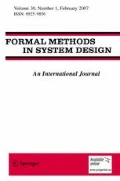Abstract
A hybrid automaton is a mathematical model for hybrid systems, which combines, in a single formalism, automaton transitions for capturing discrete updates with differential constraints for capturing continuous flows. Formal verification of hybrid automata relies on symbolic fixpoint computation procedures that manipulate sets of states. These procedures can be implemented using boolean combinations of linear constraints over system variables, equivalently, using polyhedra, for the subclass of linear hybrid automata. In a linear hybrid automaton, the flow at each control mode is given by a rate polytope that constrains the allowed values of the first derivatives. The key property of such a flow is that, given a state-set described by a polyhedron, the set of states that can be reached as time elapses, is also a polyhedron. We call such a flow a polyhedral flow. In this paper, we study if we can generalize the syntax of linear hybrid automata for describing flows without sacrificing the polyhedral property. In particular, we consider flows described by origin-dependent rate polytopes, in which the allowed rates depend, not only on the current control mode, but also on the specific state at which the mode was entered. We identify necessary and sufficient conditions for a class of flows described by origin-dependent rate polytopes to be polyhedral. We also propose and study additional classes of flows: strongly polyhedral flows, in which the set of states that can be reached up to a given time starting from a polyhedron is guaranteed to be a polyhedron, and polyhedrally sliced flows, in which the set of states that can be reached at a given time starting from a polyhedron is guaranteed to be a polyhedron. Finally, we discuss an application of the above classes of flows to approximate exponential behaviours.
Similar content being viewed by others
References
R. Alur, C. Courcoubetis, and D.L. Dill, “Model-checking in dense real-time,” Information and Computation, vol. 104, No. 1, pp. 2-34, 1993.
R. Alur, C. Courcoubetis, N. Halbwachs, T.A. Henzinger, P. Ho, X. Nicollin, A. Olivero, J. Sifakis, and S. Yovine, “The algorithmic analysis of hybrid systems,” Theoretical Computer Science, Vol. 138, pp. 3-34, 1995.
R. Alur and D.L. Dill, “A theory of timed automata,” Theoretical Computer Science, Vol. 126, pp. 183-235, 1994.
R. Alur, J. Esposito, M. Kim, V. Kumar, and I. Lee, “Formal modeling and analysis of hybrid systems. A case study in multirobot coordination,” in Proceedings of the Formal Methods'99, LNCS 1708, Springer, 1999, pp. 212-232.
R. Alur, T.A. Henzinger, and P.-H. Ho, “Automatic symbolic verification of embedded systems,” IEEE Transactions on Software Engineering, Vol. 22, No. 3, pp. 181-201, 1996.
J.R. Burch, E.M. Clarke, D.L. Dill, L.J. Hwang, and K.L. McMillan, “Symbolic model checking: 1020 states and beyond,” Information and Computation, Vol. 98, No. 2, pp. 142-170, 1992.
E.M. Clarke and E.A. Emerson, “Design and synthesis of synchronization skeletons using branching time temporal logic,” in Proc. of Workshop on Logic of Programs, LNCS 131, Springer-Verlag, 1981, pp. 52-71.
E.M. Clarke and R.P. Kurshan, “Computer-aided verification,” IEEE Spectrum, Vol. 33, No. 6, pp. 61-67, 1996.
T.A. Henzinger, P. Ho, and H. Wong-Toi, “HYTECH: A model checker for hybrid systems,” Software Tools for Technology Transfer, Vol. 1, 1997.
T.A. Henzinger, P.H. Ho, and H. Wong-Toi, “Algorithmic analysis of nonlinear hybrid systems,” IEEE Transactions on Automatic Control, Vol. 43, pp. 540-554, 1998.
T.A. Henzinger, P. Kopke, A. Puri, and P. Varaiya, “What's decidable about hybrid automata,” Journal of Computer and System Sciences, Vol. 57, pp. 94-124, 1998.
T.A. Henzinger and H. Wong-Toi, “Linear phase-portrait approximations of nonlinear hybrid systems,” in Hybrid Systems III: Verification and Control, LNCS 1066, Springer-Verlag, 1996, pp. 377-388.
P.H. Ho and H. Wong-Toi, “Automated analysis of an audio control protocol,” in Proc. of the Seventh Conference on Computer-Aided Verification, LNCS 939, Springer-Verlag, 1995, pp. 381-394.
G.J. Holzmann, “The model checker spin,” IEEE Transanctions on Software Engineering, Vol. 23, No. 5, pp. 279-295, 1997.
G. Lafferriere, G.J. Pappas, and S. Sastry, “O-minimal hybrid systems,” Mathematics of Control, Signals, and Systems, Vol. 13, No. 1, pp. 1-21, 2000.
Author information
Authors and Affiliations
Rights and permissions
About this article
Cite this article
Alur, R., Kannan, S. & La Torre, S. Polyhedral Flows in Hybrid Automata. Formal Methods in System Design 24, 261–280 (2004). https://doi.org/10.1023/B:FORM.0000026092.11691.96
Issue Date:
DOI: https://doi.org/10.1023/B:FORM.0000026092.11691.96



